Romalea microptera
| Romalea microptera | |
|---|---|
%2C_mating.jpg) | |
| Scientific classification | |
| Kingdom: | Animalia |
| Phylum: | Arthropoda |
| Class: | Insecta |
| Order: | Orthoptera |
| Family: | Acrididae |
| Genus: | Romalea |
| Species: | R. microptera |
| Binomial name | |
| Romalea microptera (Beauvois, 1817) | |
Romalea microptera (syn. Romalea guttata), known commonly as the eastern lubber grasshopper or just lubber grasshopper, is a grasshopper native to the southeastern and south central portion of the United States. It is the most distinctive grasshopper species within the southeastern United States, and is well known both for its size and its unique coloration.[1] It can reach nearly 3 inches (8 cm) in size.
It was long known as Romalea microptera before being moved to guttata.[2] However, after new research, the remaining names (including guttata) have been marked as nomina oblita and microptera takes priority once more.[3]
Life cycle
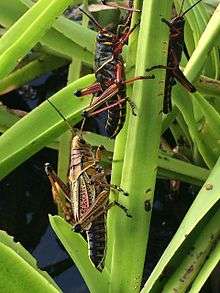
Romalea microptera goes through several stages, like all insects. When in the nymph stage, it is smaller than in the adult stage, wingless and completely black with one or more yellow, orange or red stripes. In the adult stage, they reach 2.5–3 in (64–76 mm), grow wings half the length of their body and become either a dull yellow often characterized by black spots and markings, a bright orange with black markings, or entirely black (as in the nymph stage) with yellow or red striping. In the black adult color phase, the grasshopper is widely known by the name "diablo" or "black diablo". In Louisiana, they are known as the "Devil's horse" or "cheval-diable". The insect is also colloquially known as a "graveyard grasshopper". In Mississippi they are known as "giant locust".[4]
Location
Romalea microptera inhabits regions west of North Carolina to Tennessee, in Georgia, Alabama, Mississippi, Louisiana, Arkansas and Texas, and throughout Florida, Missouri and Arizona. They live in open pinewoods, weedy vegetation and weedy fields. Sometimes these grasshoppers live in sewers, since grass and other food sources accumulate there.[1]
Size and wings
Romalea microptera can reach net 3 in (76 mm) in size. Their wings are rarely ½ the length of the abdomen; most of the time they are much smaller than that, and cannot be used for flight.[1]
Defense
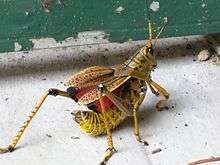
Romalea microptera has several defense strategies. The first is its brightly colored warning pattern (aposematism). Additionally, the insect emits a foul-smelling and foul-tasting foamy secretion from the thorax when it is disturbed. The secretion is dark colored and opaque. It also lets off a loud hissing sound that can scare animals.[1]
Gallery
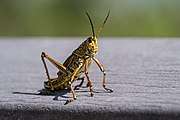 Female eastern lubber grasshopper (romalea microptera) in Everglades National Park, Florida, USA
Female eastern lubber grasshopper (romalea microptera) in Everglades National Park, Florida, USA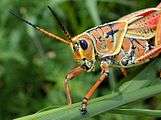 Close-up of Romalea microptera from Everglades
Close-up of Romalea microptera from Everglades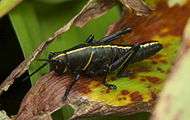 Nymph Romalea microptera with its characteristic black and yellow striped body
Nymph Romalea microptera with its characteristic black and yellow striped body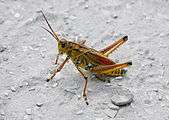 Lubber grasshopper, Loxahatchee National Wildlife Refuge, Delray, Florida.
Lubber grasshopper, Loxahatchee National Wildlife Refuge, Delray, Florida. Adult dark morph, University of Mississippi Field Station
Adult dark morph, University of Mississippi Field Station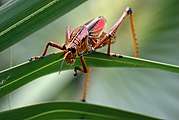 Romalea microptera at a Slought in Florida,USA
Romalea microptera at a Slought in Florida,USA
References
- 1 2 3 4 C. W. Scherer (February 2008). "Eastern Lubber Grasshopper, Romalea microptera (Beauvois) (= guttata (Houttuyn)) (Insecta: Orthoptera: Acrididae)". University of Florida.
- ↑ D. K. M. Kevan (1980). "Romalea guttata (Houttuyn), name change for well-known "eastern lubber grasshopper" (Orthoptera: Romaleidae)". Entomological News. 91 (4): 139–140.
- ↑ "Species Romalea microptera - Eastern Lubber Grasshopper". Bugguide.net. August 1, 2014. Retrieved June 9, 2015.
- ↑ Richard Fox (October 6, 2006). "Romalea microptera, Eastern Lubber Grasshopper". Invertebrate Anatomy Online. Lander University. Archived from the original on February 19, 2012. Retrieved April 4, 2011.
External links

- Sarah Sue Goldsmith (May 4, 1999). "Black grasshoppers munch their way across South Louisiana". Louisiana State University.